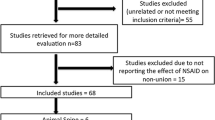Abstract
Background
The current mainstay of orthopaedic pain control is opioid analgesics but there are few studies in the literature evaluating the effects of opioids on bone healing.
Questions/purposes
The purpose of this study was to use a rat fracture model to evaluate the effects of opioid administration on osseous union in the acute (4 weeks) and subacute (8 weeks) setting in an operatively stabilized fracture. We asked the following question: does morphine administration alter (1) fracture callus strength; (2) callus volume and formation; and (3) morphology and early remodeling to final osseous union?
Methods
A 0.4-mm femoral osteotomy gap was created in 50 Sprague-Dawley rats using an established model. Postoperatively, rats were randomized to control versus morphine-treated study groups. Equal numbers of rats from each group were euthanized at 4 weeks and 8 weeks postoperatively. Three-point bend biomechanical testing was performed to evaluate postoperative callus strength. Micro-CT scans and histological analyses were used to evaluate postoperative callus volume and formation, morphology, and features of early remodeling.
Results
Biomechanical testing identified a statistically significant (p = 0.048) reduction in callus strength in morphine-treated animals 8 weeks postoperatively compared with controls. Radiographic and histological analysis showed delayed callus maturation and lack of remodeling in the morphine group compared with control animals at 8 weeks. Micro-CT analysis expressed remodeling and resorption as a decrease in callus volume over the two time points. The control group had significant levels of resorption decreasing 29% (p = 0.023) over the 4-week to 8-week time interval. Morphine administration inhibited callus resorption and remodeling with only a 13% decrease (p = 0.393) in callus volume comparing these time points. The callus inhibition associated with morphine administration was not as evident in the acute, 4-week time setting.
Conclusions
Morphine administration inhibited callus strength in this animal model. This finding is likely consistent with the observation that the callus and healing bone appear to have a decreased rate of maturation and remodeling seen at 8 weeks.
Clinical Relevance
This study identifies that administration of an opioid pain medication leads to weaker callus and impedes callus maturation compared with controls. These findings may provide the impetus to alter our current orthopaedic analgesic gold standard toward more multimodal and opioid-limiting pain control regimens.




Similar content being viewed by others
References
Antonova E, Le TK, Burge R, Mershon J. Tibia shaft fractures: costly burden of nonunions. BMC Musculoskelet Disord. 2013;14:42.
Bhattacharyya T, Levin R, Vrahas MS, Solomon DH. Nonsteroidal anti-inflammatory drugs and nonunion of humeral shaft fractures. Arthritis Rheum. 2005;53:364–367.
Brinker MR, O’Connor DP, Monla YT, Earthman TP. Metabolic and endocrine abnormalities in patients with nonunions. J Orthop Trauma. 2007;21:557–570.
Brown KM, Saunders MM, Kirsch T, Donahue HJ, Reid JS. Effect of COX-2-specific inhibition on fracture-healing in the rat femur. J Bone Joint Surg Am. 2004;86:116–123.
Einhorn TA. Enhancement of fracture healing. Instr Course Lect. 1996;45:401–416.
Green E, Lubahn JD, Evans J. Risk factors, treatment, and outcomes associated with nonunion of the midshaft humerus fracture. J Surg Orthop Adv. 2005;14:64–72.
Grey A, Rix-Trott K, Horne A, Gamble G, Bolland M, Reid IR. Decreased bone density in men on methadone maintenance therapy. Addiction. 2011;106:349–354.
Hernandez RK, Do TP, Critchlow CW, Dent RE, Jick SS. Patient-related risk factors for fracture-healing complications in the United Kingdom General Practice Research Database. Acta Orthop. 2012;83:653–660.
King T, Vardanyan A, Majuta L, Melemedjian O, Nagle R, Cress AE, Vanderah TW, Lai J, Porreca F. Morphine treatment accelerates sarcoma-induced bone pain, bone loss, and spontaneous fracture in a murine model of bone cancer. Pain. 2007;132:154–168.
Lindenhovius AL, Helmerhorst GT, Schnellen AC, Vrahas M, Ring D, Kloen P. Differences in prescription of narcotic pain medication after operative treatment of hip and ankle fractures in the United States and The Netherlands. J Trauma. 2009;67:160–164.
Miller M, Stürmer T, Azrael D, Levin R, Solomon DH. Opioid analgesics and the risk of fractures in older adults with arthritis. J Am Geriatr Soc. 2011;59:430–438.
Moghaddam A, Zimmermann G, Hammer K, Bruckner T, Grützner PA, von Recum J. Cigarette smoking influences the clinical and occupational outcome of patients with tibial shaft fractures. Injury. 2011;42:1435–1442.
Pountos I, Georgouli T, Calori GM, Giannoudis PV. Do nonsteroidal anti-inflammatory drugs affect bone healing? A critical analysis. Scientific World Journal. 2012;2012:606404.
Praemer A, Furner S, Rice DP, eds. Musculoskeletal Conditions in the United States. Park Ridge, IL, USA: American Academy of Orthopaedic Surgeons; 1992.
Schmidhammer R, Zandieh S, Mittermayr R, Pelinka LE, Leixnering M, Hopf R, Kroepfl A, Redl H. Assessment of bone union/nonunion in an experimental model using microcomputed technology. J Trauma. 2006;61:199–205.
Acknowledgments
We thank Dr Kent Bachus for his guidance in developing an animal model and biomechanical expertise and Saranne Gross for her technical assistance throughout the duration of this study.
Author information
Authors and Affiliations
Corresponding author
Additional information
Funding for this study was provided by an Orthopaedic Research and Education Foundation’s (OREF)/Synthes Resident Research Project Grant and a departmental grant from the Sherman S. Coleman Resident Research Fund. Synthes Research Project Support donated surgical supplies/instruments. One of the authors (KBJ) receives career development support from the National Cancer Institute (K08CA138764).
All ICMJE Conflict of Interest Forms for authors and Clinical Orthopaedics and Related Research editors and board members are on file with the publication and can be viewed on request.
Clinical Orthopaedics and Related Research neither advocates nor endorses the use of any treatment, drug, or device. Readers are encouraged to always seek additional information, including FDA-approval status, of any drug or device prior to clinical use.
Each author certifies that his or her institution approved the animal protocol for this investigation and that all investigations were conducted in conformity with ethical principles of research.
All work was performed at the University of Utah campus, Salt Lake City, UT, USA.
About this article
Cite this article
Chrastil, J., Sampson, C., Jones, K.B. et al. Postoperative Opioid Administration Inhibits Bone Healing in an Animal Model. Clin Orthop Relat Res 471, 4076–4081 (2013). https://doi.org/10.1007/s11999-013-3232-z
Received:
Accepted:
Published:
Issue Date:
DOI: https://doi.org/10.1007/s11999-013-3232-z




